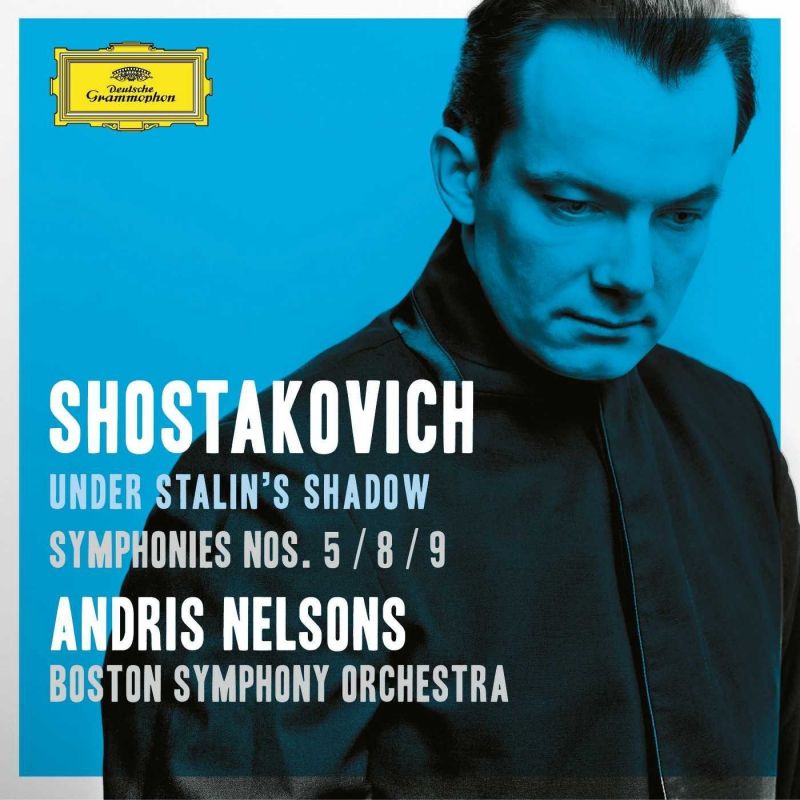SHOSTAKOVICH Symphonies Nos 5, 8 & 9
View record and artist detailsRecord and Artist Details
Composer or Director: Dmitri Shostakovich
Genre:
Orchestral
Label: Deutsche Grammophon
Magazine Review Date: 08/2016
Media Format: CD or Download
Media Runtime: 157
Mastering:
DDD
Catalogue Number: 479 5201GH2

Tracks:
| Composition | Artist Credit |
|---|---|
| Symphony No. 9 |
Dmitri Shostakovich, Composer
Andris Nelsons, Conductor Boston Symphony Orchestra Dmitri Shostakovich, Composer |
| Symphony No. 5 |
Dmitri Shostakovich, Composer
Andris Nelsons, Conductor Boston Symphony Orchestra Dmitri Shostakovich, Composer |
| Hamlet, Movement: Excerpts |
Dmitri Shostakovich, Composer
Andris Nelsons, Conductor Boston Symphony Orchestra Dmitri Shostakovich, Composer |
| Symphony No. 8 |
Dmitri Shostakovich, Composer
Andris Nelsons, Conductor Boston Symphony Orchestra Dmitri Shostakovich, Composer |
Author: Edward Seckerson
The Ninth, of course, was (along with the Sixth) a calculated surprise on the part of the composer – a piece clearly designed to wrong-foot the establishment, whose expectation was for something ‘other’: in this case something which might pointedly celebrate the Soviet victory over the Nazis. But Shostakovich wasn’t about to wave the flag for Stalin under any circumstances and the quirky Ninth is a V-sign (the other kind) to oppression rather closer to home.
Nelsons is spry and precisioned and his insistence on super-keen rhythm pays off big-time. Really notable in the first movement is the way in which he deploys accents and subito fortes – the aural equivalent of tongues irreverently poked out at any and every authority. The wistful understatement of the second-movement Moderato is then countered by an absolutely blistering Presto – a dazzling display of orchestral juggling skills, not least from the tumbling Boston woodwinds. I love, too, the way the ensuing trombone proclamation (sonorously over-egged here) seems to portend an epic slow movement when in fact the solitary bassoon’s failure to encourage others to join in his lament leaves him no alternative but to send in the clowns. They arrive with the pompous Red Army Band in tow and Nelsons again really underlines the cynicism.
Tom Stoppard’s Rosencrantz and Guildenstern would have recognised the coarse irreverence of Shostakovich’s Elsinore – this being the first of the composer’s brushes with Shakespeare’s tragedy in the shape of Nikolai Asimov’s farcical 1932 Moscow production of Hamlet which predictably annoyed Party officials almost as much as it might have amused the author. Even Ophelia skips off to her watery grave, pathos reduced to bathos as the body count rises. Nelsons lends the Suite from that score a rollocking irony so that even the appearance of the ‘Dies irae’ in the closing ‘Requiem’ sounds like a bad joke.
So to the great Eighth Symphony, repeatedly shaken as it is by the remorseless thunder of war. The Soviets thought it irredeemably gloomy but Nelsons finds beauty in its hopefulness. The long cor anglais solo emerging from the seismic upheaval of percussion in the first movement shows just how this consolation in adversity can work and the alliance of cellos and basses in this performance repeatedly finds poetry in the searching bass-lines. It’s amazing how tender a sound so sombre can be.
But it has to be said that Nelsons never quite goes to that dark place that the old guard like Mravinsky recognise so well, and at times one simply wants more of the trenchancy that Nelsons’s account of the Tenth Symphony’s Scherzo gave us in spades. The ferocious third-movement Allegro non troppo is implacably deliberate (non troppo) and there is a wicked bite to the trombones when they take up the Toccata – but surely the first trumpet needs to be coarser in the Trio and surely that timpani-driven crescendo should threaten to rip the piece apart at the seams? It doesn’t – quite.
The Fifth Symphony is quite marvellous, though, and like the Tenth should dominate the catalogue for a long time to come. I love the way the first subject sounds for all the world like a remnant of Tchaikovsky’s legacy as opposed to ‘a Soviet artist’s reply to just criticism’. The romantic nature of the piece is lushly served – nowhere more so than in the ravishing Largo, infused as it is with the spirit of star-crossed lovers (Shostakovich almost invoking the fragrant world of Prokofiev’s Romeo and Juliet) and quite wonderfully chronicled by the Boston Symphony strings – as downy in repose as they are intense in extremis. The entire movement sounds ‘headier’ than I’ve ever heard it since the famous Previn/LSO recording from the 1960s. The hushed celesta-flecked coda is breathtaking.
There is high drama as well as beauty, though, and the first movement is ripe with bold contrasts. Out of the seraphic second subject comes the militaristic development, wildly exciting with trumpets flaring thrillingly at the transition into the goose-stepping march – a real volte-face – and Nelsons is masterly in screwing up the tension right through to the crushing trombone inversion of the opening bars. The finale, too, brings thrills and spills – a rip-roaring central climax for one (just listen to the trumpets’ sforzando fanfares) – and now that interpreters have finally sorted out the metronome marking we continue to get the colossal irony of the ‘oppressively’ triumphal coda. To say that it brings the house down is something of an understatement.
Discover the world's largest classical music catalogue with Presto Music.

Gramophone Digital Club
- Digital Edition
- Digital Archive
- Reviews Database
- Full website access
From £8.75 / month
Subscribe
Gramophone Full Club
- Print Edition
- Digital Edition
- Digital Archive
- Reviews Database
- Full website access
From £11.00 / month
Subscribe
If you are a library, university or other organisation that would be interested in an institutional subscription to Gramophone please click here for further information.




